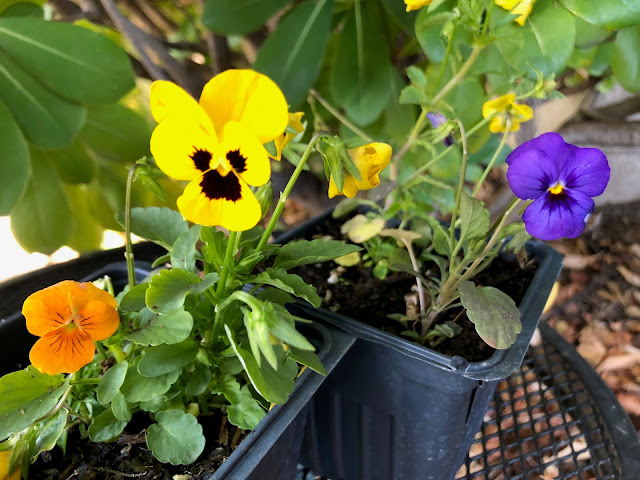
Late September ideal for transplanting (but remember to water)

|
|
The weather's perfect for planting cool-weather annuals including pansies and violas. (Photo: Kathy Morrison)
|
The heat is back and so is high fire danger.
In addition to temperatures pushing 100 degrees, strong winds (15 to 30 mph with gusts to 50 mph) and low humidity (10 to 20%) are forecast for the next two days. The National Weather Service has issued a red flag warning Saturday night through Monday evening, Sept. 28.
What that means: Watch out for wildfire. A spark from a lawnmower or other equipment can ignite dried grass or leaves. Take extra precaution while outdoors.
Hot, dry weather with temperatures about 10 degrees above average is expected to continue throughout the week, according to Sacramento’s weather forecast. But mornings will be pleasantly in the 60s and 70s – and busy.
The warm weather is keeping soil warm, too; great for planting! Just remember to keep garden additions well watered.
Traditionally, late September and October are ideal for planting in Sacramento. That includes transplanting shrubs, trees or perennials or starting a cool weather vegetable garden.
Need some specifics?
* In the vegetable garden, plant onions, lettuce, peas, radishes, turnips, beets, carrots, bok choy, spinach and potatoes directly into that warm soil.
* Transplant cabbage, broccoli, kale, Brussels sprouts, cauliflower and lettuce seedlings.
* Sow seeds of California poppies, clarkia and African daisies.
* Transplant cool-weather annuals such as pansies, violas, fairy primroses, calendulas, stocks and snapdragons.
* Divide and replant bulbs, rhizomes and perennials.
* Dig up and divide daylilies as they complete their bloom cycle.
* Divide and transplant peonies that have become overcrowded. Replant with "eyes" about an inch below the soil surface.
* Late September is ideal for sowing a new lawn or re-seeding bare spots.
Comments
0 comments have been posted.Sacramento Digs Gardening to your inbox.
Food in My Back Yard Series
April 1: Don't be fooled by these garden myths
March 25: Fertilizer tips: How to 'feed' your vegetables for healthy growth
March 18: Time to give vegetable seedlings some more space
March 11: Ways to win the fight against weeds
March 4: Potatoes from the garden
Feb. 25: Plant a fruit tree now -- for later
Feb. 18: How to squeeze more food into less space
Feb. 11: When to plant? Consider staggering your transplants
Feb. 4: Starting in seed starting
Sites We Like
Garden Checklist for week of March 30
Your garden doesn’t mind April showers. Get busy now to enjoy those future flowers.
* Get ready to swing into action in the vegetable garden. As nights warm up over 50 degrees, start setting out tomato, pepper and eggplant transplants.
* From seed, plant beans, beets, cantaloupes, carrots, corn, cucumbers, melons, pumpkins, radishes and squash. (Soak beet seeds overnight in water for better germination,)
* Plant onion sets.
* In the flower garden, plant seeds for asters, cosmos, celosia, marigolds, salvia, sunflowers and zinnias.
* Transplant petunias, zinnias, geraniums and other summer bloomers.
* Plant perennials and dahlia tubers for summer bloom.
* Transplant lettuce and cabbage seedlings.
* April is the last chance to plant citrus trees such as dwarf orange, lemon and kumquat. These trees also look good in landscaping and provide fresh fruit in winter.
* Smell orange blossoms? Feed citrus trees with a low dose of balanced fertilizer (such as 10-10-10) during bloom to help set fruit. Keep an eye out for ants.
* Apply slow-release fertilizer to the lawn.